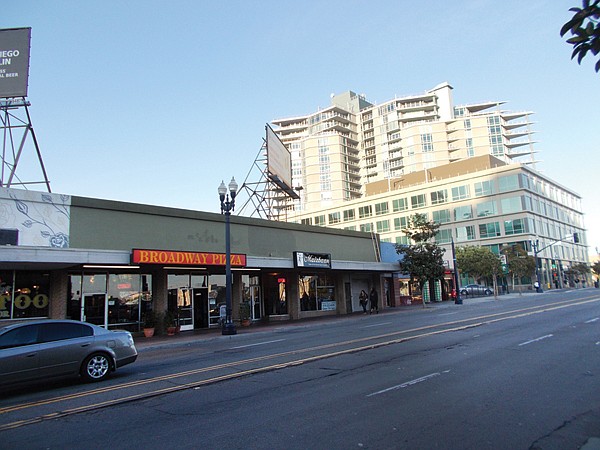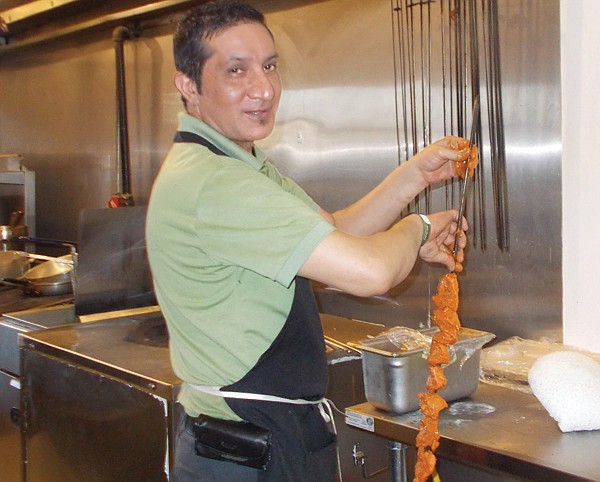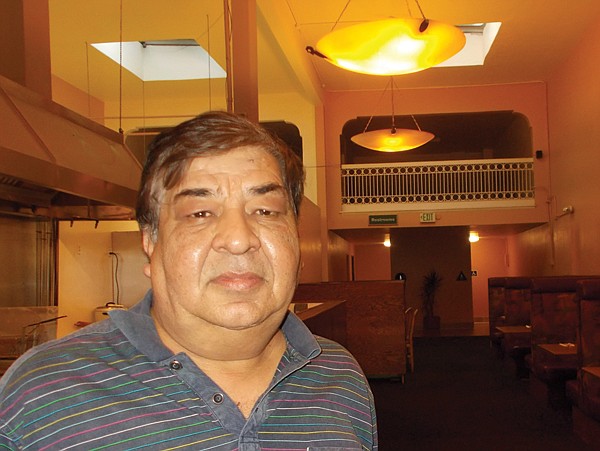 Facebook
Facebook
 X
X
 Instagram
Instagram
 TikTok
TikTok
 Youtube
Youtube

‘Suba bakhair,” says Saba.
She’s teaching me how to say “Good morning” in Urdu, the language they speak in Pakistan.
That’s where she’s from, like most of the people in this place on Broadway: Maizbaan. It’s just east of Lucky’s Tattoo and its neighbor, Broadway Pizza, near the corner of Tenth. A turbaned gent is its symbol.
Turns out maizbaan means “host” in Urdu.
This is the first place I’ve seen that serves Pakistani food, and I can see they’re serious. They’ve set up a tandoori oven and racks of four-foot spears to drop stabbed chunks of meat into it for a couple of minutes.
You go through double doors that tell the history — “Broadway Linoleum and Carpet Co,” says the tiling under your feet.

Inside’s cavernous, with tables scattered in the front part and the middle section divided between booths and a big kitchen that juts out from the left wall.
Paintings of crashing waves and watermills look small on the way-big green and yellow walls, but potted palms help the place look less empty. The smells coming from the kitchen tell you we’re in the land of curries and kabobs. I have to walk over to where the cooking action’s going on.
This chef named Kshabby is hanging up a spear-load of red chicken meat. He’s just taken it smoking out of the tandoori oven. He stirs a huge pot of frying onions — “Onions are the basis for all Pakistani curries,” he says — and starts working on a skillet loaded with a creamy red sauce and meat. “Chicken tikka masala,” he says.
I could hang around, just to suck in all the garlicky, oniony, curry smells but have to make a few decisions here. So I go back to my booth and sit.
Guy comes with the menu. Yawar. This is his place. “We’ve opened recently,” he says. He’s from Pakistan, but he’s been running Broadway Pizza next door for 21 years.
Food ranges from $5 to $10, more for double portions. I start off with the one thing I know: samosas — deep-fried pastry triangles stuffed with peas, lentils, potato, onion. They go for $4.99 for three. Actually, I should have ordered the beef, because the vegetable ones don’t have any taste you can nail, apart from the fried pastry. You do get pots of red tamarind sauce and raita (a yogurt and green-chili mix) to dunk them in. That helps.
I check out the rest of the menu.
“What’s the difference between Indian and Pakistani food?” I ask Yawar.

“Indian food is usually vegetarian,” he says. “Pakistanis like their meat and their heat. Our food is generally spicier than Indian food.”
But the one I end up ordering is as gentle as they come, a dish the lovely Carla always raves about: chicken tikka masala — like, that scrumptious-smelling stuff I saw the cook stirring on the stove ($8.99 with salad). “Tikka” means “bits, pieces,” and “masala” means “a mixture of spices.”
Plus, what the heck, I order a naan bread ($1.99), made by slapping raw dough against a hot clay wall. How hot? Up to 900 degrees. The naan bakes in a matter of minutes.
Oh, yes. Totally delicious. How can you not love the creamy orange sauce and the chicken chunks marinated in yogurt and all kinds of spices, then baked on those skewers? Heck, tandoor ovens have hardly changed in 5000 years.
The irony is that chicken tikka masala may have come from…Scotland. They say a Pakistani chef in Glasgow whipped up a mixture of yogurt, cream, and spices when he had to come up with something quick and — voilà!
I bring some home to Carla. She knows a lot more about this food than I do, and she pronounces it A-okay. So much so that she sends me back a couple of days later for more. I arrive at about 5:00 p.m., order up Carla’s chicken tikka masala, then, for myself, decide to try something new.
Start off with samosas again, but, this time, it’s the beef-filled ones ($5.99). What a difference. The beef is spicy, lemony, interesting. Now that raita really speaks.
My server this time is Alex. He’s from Lahore.
“So, what’s really Pakistani on the menu?” I ask.

“A goat karahi ($10.99),” he says. “That’s very traditional. Ginger’s the prominent spice, but it also has garlic, onions, tomatoes, cilantro…”
“What’s karahi?” I ask.
“I’ll show you.”
Ten minutes later, he’s cooking my chopped-up goat meat in a big wok.
“We call this pan a karahi,” he says. “Food cooked in the karahi is also called karahi.”
He delivers the dish steaming in a soup plate. “This is good for you,” he says. “Ginger. It’s great for joint pains and it gives you calcium.”
This is one hot stew. Steaming and spicy, thick with sliced jalapeños. Whew! It has that slightly gamey goat taste, but it totally works with the ginger and onions and garlic.
And, man, it’s not over yet. Alex persuades me to have a dessert. Ooh…orange-colored. Warm. Tastes of…carrots.
“It’s gajar halwar ($4.99),” says Alex, “‘sweet carrots, cooked in milk.”
On top is a combo of chopped almonds and pistachios. A delish way to end the meal.
The main takeaway is that here you get to see a bit of Pakistan — people and culture and cooking ideas you want to be a part of. After the headlines of the past few years, that feels good.


‘Suba bakhair,” says Saba.
She’s teaching me how to say “Good morning” in Urdu, the language they speak in Pakistan.
That’s where she’s from, like most of the people in this place on Broadway: Maizbaan. It’s just east of Lucky’s Tattoo and its neighbor, Broadway Pizza, near the corner of Tenth. A turbaned gent is its symbol.
Turns out maizbaan means “host” in Urdu.
This is the first place I’ve seen that serves Pakistani food, and I can see they’re serious. They’ve set up a tandoori oven and racks of four-foot spears to drop stabbed chunks of meat into it for a couple of minutes.
You go through double doors that tell the history — “Broadway Linoleum and Carpet Co,” says the tiling under your feet.

Inside’s cavernous, with tables scattered in the front part and the middle section divided between booths and a big kitchen that juts out from the left wall.
Paintings of crashing waves and watermills look small on the way-big green and yellow walls, but potted palms help the place look less empty. The smells coming from the kitchen tell you we’re in the land of curries and kabobs. I have to walk over to where the cooking action’s going on.
This chef named Kshabby is hanging up a spear-load of red chicken meat. He’s just taken it smoking out of the tandoori oven. He stirs a huge pot of frying onions — “Onions are the basis for all Pakistani curries,” he says — and starts working on a skillet loaded with a creamy red sauce and meat. “Chicken tikka masala,” he says.
I could hang around, just to suck in all the garlicky, oniony, curry smells but have to make a few decisions here. So I go back to my booth and sit.
Guy comes with the menu. Yawar. This is his place. “We’ve opened recently,” he says. He’s from Pakistan, but he’s been running Broadway Pizza next door for 21 years.
Food ranges from $5 to $10, more for double portions. I start off with the one thing I know: samosas — deep-fried pastry triangles stuffed with peas, lentils, potato, onion. They go for $4.99 for three. Actually, I should have ordered the beef, because the vegetable ones don’t have any taste you can nail, apart from the fried pastry. You do get pots of red tamarind sauce and raita (a yogurt and green-chili mix) to dunk them in. That helps.
I check out the rest of the menu.
“What’s the difference between Indian and Pakistani food?” I ask Yawar.

“Indian food is usually vegetarian,” he says. “Pakistanis like their meat and their heat. Our food is generally spicier than Indian food.”
But the one I end up ordering is as gentle as they come, a dish the lovely Carla always raves about: chicken tikka masala — like, that scrumptious-smelling stuff I saw the cook stirring on the stove ($8.99 with salad). “Tikka” means “bits, pieces,” and “masala” means “a mixture of spices.”
Plus, what the heck, I order a naan bread ($1.99), made by slapping raw dough against a hot clay wall. How hot? Up to 900 degrees. The naan bakes in a matter of minutes.
Oh, yes. Totally delicious. How can you not love the creamy orange sauce and the chicken chunks marinated in yogurt and all kinds of spices, then baked on those skewers? Heck, tandoor ovens have hardly changed in 5000 years.
The irony is that chicken tikka masala may have come from…Scotland. They say a Pakistani chef in Glasgow whipped up a mixture of yogurt, cream, and spices when he had to come up with something quick and — voilà!
I bring some home to Carla. She knows a lot more about this food than I do, and she pronounces it A-okay. So much so that she sends me back a couple of days later for more. I arrive at about 5:00 p.m., order up Carla’s chicken tikka masala, then, for myself, decide to try something new.
Start off with samosas again, but, this time, it’s the beef-filled ones ($5.99). What a difference. The beef is spicy, lemony, interesting. Now that raita really speaks.
My server this time is Alex. He’s from Lahore.
“So, what’s really Pakistani on the menu?” I ask.

“A goat karahi ($10.99),” he says. “That’s very traditional. Ginger’s the prominent spice, but it also has garlic, onions, tomatoes, cilantro…”
“What’s karahi?” I ask.
“I’ll show you.”
Ten minutes later, he’s cooking my chopped-up goat meat in a big wok.
“We call this pan a karahi,” he says. “Food cooked in the karahi is also called karahi.”
He delivers the dish steaming in a soup plate. “This is good for you,” he says. “Ginger. It’s great for joint pains and it gives you calcium.”
This is one hot stew. Steaming and spicy, thick with sliced jalapeños. Whew! It has that slightly gamey goat taste, but it totally works with the ginger and onions and garlic.
And, man, it’s not over yet. Alex persuades me to have a dessert. Ooh…orange-colored. Warm. Tastes of…carrots.
“It’s gajar halwar ($4.99),” says Alex, “‘sweet carrots, cooked in milk.”
On top is a combo of chopped almonds and pistachios. A delish way to end the meal.
The main takeaway is that here you get to see a bit of Pakistan — people and culture and cooking ideas you want to be a part of. After the headlines of the past few years, that feels good.